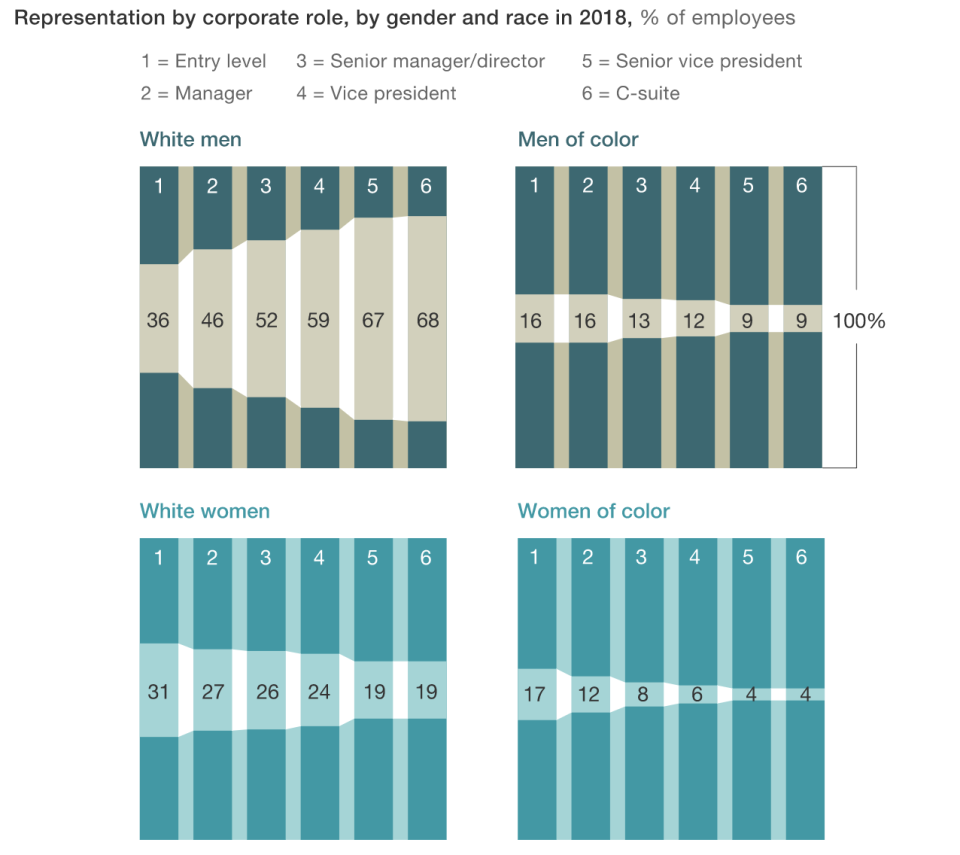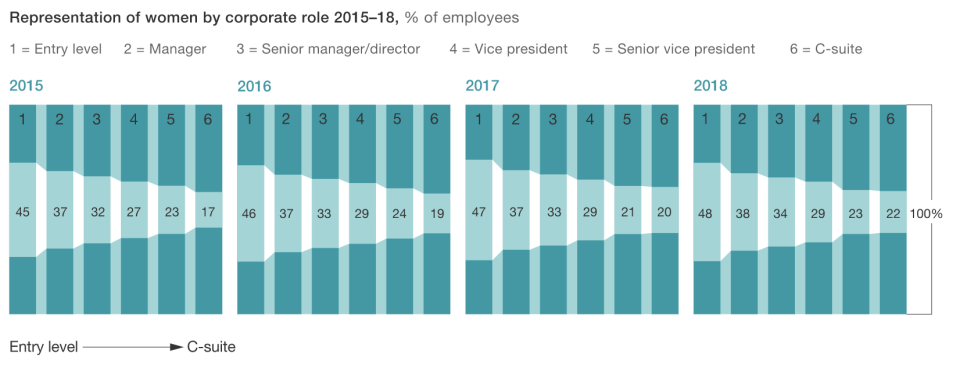The stark reality of how global workplaces have a woman workforce problem

Workplaces around the world have a woman problem — they are just not promoting or hiring them in top positions, which in turn hinders closing the gender pay gap.
The gender pay gap is mainly due to the lack of women in senior jobs, which pay more, meaning the average is massively skewed.
A new report by The Pipeline consultancy sheds a damning light on what progress is actually being made in making sure women are represented across all levels of an organisation, not just in lower positions.
The report looked at the 350 largest listed companies in Britain and also looked at statistics from the biggest companies across major economies, such as Germany and Hong Kong.
There are nine statistics that stood out and showed how, as described by Pipeline, was it was “another wasted year,” in improving diversity across companies.
CEOs: Only 3.7% of FTSE 350 companies women at the helm of the company as chief executive officer. This a 4.6% decline from two years ago.
Executive boards: There are no women executives on main boards of over 85% of FTSE 350 companies.
Executive directors: Only 9% of executive directors on main boards are women — unchanged since 2017
Executive committee members: Only 17.1% are women. This only signals a 0.8% since 2018. A fifth of FTSE 350 companies have no female members on these committees at all.
Vital responsibilities: Just 5% of executive committee positions are held by women in roles with profit and loss (P&L) responsibility. Over half of FTSE 350 companies have no women on their executive committees in a P&L role at all.
Global trend: Pipeline says that when you look at other major economies and replicate the methodology to major company indices, the statistics are just as bleak. For example, India and Germany have no women CEOs at all, while China, Hong Kong, the USA, Spain and France have only one each
The consultancy points out that “at the current rate of progress, it will be almost 2090 before executive committees achieve gender balance.”
“It is patently self-harming for companies not to address these problems of gender imbalance at the top. So why don’t they? Where there are already women at the top of companies, the evidence shows they are much better at progressing other female talent.”
The talent pipeline problem
Companies around the world are struggling to fix their pipeline problem. This is when, even if there is an even gender split at the beginning of the career ladder, the more senior roles become, the fewer women move up the pipeline.
In turn, since women are squeezed out of senior positions early on, especially after middle management, this means it become less and less likely that women gain top jobs.
This is even despite stats that show that companies with more female managers make more money and are more profitable overall. Meanwhile various other studies have showed the more diverse teams and companies are, the more revenue they make.
However, women are still being prevented for reaching senior positions are still inexplicable.
“Research reveals that women CEOs have twice the average number of women in executive positions than their male counterparts, and FTSE 350 companies led by women have an average of seven times more female executives on their main board than those led by men,” said Pipeline in the report.
“It is hard not to conclude that where men are in charge, they tend not to want to let go of their grip and allow women a share of the action.”
This sentiment was shared by a now annual benchmark report, entitled “Women in the Workplace,” conducted by major consultancy McKinsey. In its latest report, which is based on four years of data from 462 companies employing more than 19.6 million people, McKinsey said that “two things are clear: one, women remain underrepresented, particularly women of colour. Two, companies need to change the way they hire and promote entry and manager-level employees to make real progress.”

Much like Pipeline’s report, McKinsey says “for the fourth year in a row, attrition does not explain the underrepresentation of women. Women and men are leaving their companies at similar rates, and they have similar intentions to remain in the workforce.”
McKinsey points out that hiring and promotion of women is key to making progress on these numbers.
“This early inequality has a profound impact on the talent pipeline. Starting at the manager level, there are significantly fewer women to promote from within and significantly fewer women at the right experience level to hire in from the outside,” the group says.
“So even though hiring and promotion rates improve at more senior levels, women can never catch up—we’re suffering from a ‘hollow middle.’ This should serve as a wake-up call: until companies close the early gaps in hiring and promotion, women will remain underrepresented.”

The group also delivered a stark warning if companies continue to hire and promote women to manager at current rates.
McKinsey says, if companies continue to do so, “the number of women in management will increase by just one percentage point over the next ten years. But are companies start hiring and promoting women and men to manager at equal rates, we should get close to parity in management—48% women versus 52% men—over the same ten years.
Why this stops closing the gender pay gap
The World Economic Forum revealed in December last year that it is going to take 108 years to close the overall gender gap and 202 years to bring about parity in the workplace. Women currently get paid 63% of what men get paid.
But the global pay gap isn’t necessarily due to women being paid less for doing the same job. There are a number of factors that go into it, such as women more likely working in sectors that are lower paid — some economists use the word “choice” but this is up for debate. There are also other factors such as the “motherhood penalty.”
Increasingly, a key reason for has been identified for this pay gap.
The largest companies and institutions in the world, which account for huge swathes of the workforce, point out that the persistent pipeline problem has meant that serious underrepresentation of women in senior roles means they are earning less.
The Bank of England (BoE), which employs over 4,000 people, published a report which revealed female staff earn 20-25% less than men at the bank, in terms of both salary and bonus.
The BoE said it is trying to tackle the reason why there is a gulf between pay.
“We’re confident that men and women are paid equally for doing the same job at the Bank; however, the greater proportion of men than women in senior roles creates a gender pay gap,” said BoE governor Mark Carney in the report.
Another example is shown at Deloitte UK, which published its gender pay gap numbers under UK law that requires employers with more than 250 employees to do so.

The solution isn’t a quick-fix and this is why progress is slow.
Multi-national law firm Baker McKenzie has pointed out how “a key cause of the gap is the lack of women in senior roles. However, while many employers have focused on recruitment, recruitment alone is not the answer.
“Companies are now recognising that they need to be doing more to retain women and help them progress. Yet, men currently outpace women in terms of promotion at every stage.”

 Yahoo News
Yahoo News 

